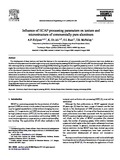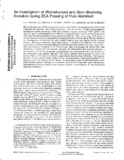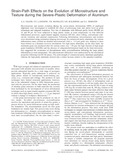Influence of ECAP processing parameters on texture and microstructure of commercially pure aluminum
| dc.contributor.author | Zhilyaev, A. P. | |
| dc.contributor.author | Oh-ishi, K. | |
| dc.contributor.author | Raab, G. I. | |
| dc.contributor.author | McNelley, T. R. | |
| dc.date.accessioned | 2014-08-29T17:47:55Z | |
| dc.date.available | 2014-08-29T17:47:55Z | |
| dc.date.issued | 2006-08-08 | |
| dc.identifier.citation | Materials Science and Engineering a, v. 441, 2006, pp. 245-252 | |
| dc.identifier.uri | https://hdl.handle.net/10945/43163 | |
| dc.description.abstract | The development of shear textures and band-like features in the microstructure of commercially pure (CP) aluminum have been studied as a function of backpressure and die relief angle during equal-channel angular pressing (ECAP) through a die with a 90◦ die channel angle. Microtexture data were acquired by orientation imaging microscopy (OIM) following one pass and four repetitive passes by route A. In a 90◦ die with zero relief angle, the microtexture data indicate that ECAP involves simple shear on a shear plane and in a shear direction that are rotated away from the plane of the die channel intersection toward the die exit channel. This rotation reflects the spreading of shear deformation through a fan-shaped region around the plane of the die channel intersection. The superposition of backpressure suppresses this spreading and the texture data indicate that deformation is confined to the plane of the die channel intersection, while the introduction of a relief angle at the outer corner of the die channel intersection promotes spreading and leads to further rotation of the shear plane and shear direction toward the axis of the die exit channel. Splitting of shear texture components is observed after the initial ECAP pass. Such splitting appears in the microstructure as band-like features separated by sub-grains. Band-like features became apparent in the microstructure after the initial pass and persisted through four ECAP passes by route A; these features become more prominent with increasing die relief angle. | en_US |
| dc.publisher | Elsevier | en_US |
| dc.rights | This publication is a work of the U.S. Government as defined in Title 17, United States Code, Section 101. Copyright protection is not available for this work in the United States. | en_US |
| dc.title | Influence of ECAP processing parameters on texture and microstructure of commercially pure aluminum | en_US |
| dc.type | Article | en_US |
| dc.contributor.corporate | Naval Postgraduate School | |
| dc.contributor.department | Department of Mechanical and Astronautical Engineering | |
| dc.subject.author | Aluminum | en_US |
| dc.subject.author | Equal channel angular pressing (ECAP) | en_US |
| dc.subject.author | Testure | en_US |
| dc.subject.author | Simple shear | en_US |
| dc.subject.author | Orientation imaging microscopy (OIM) | en_US |





